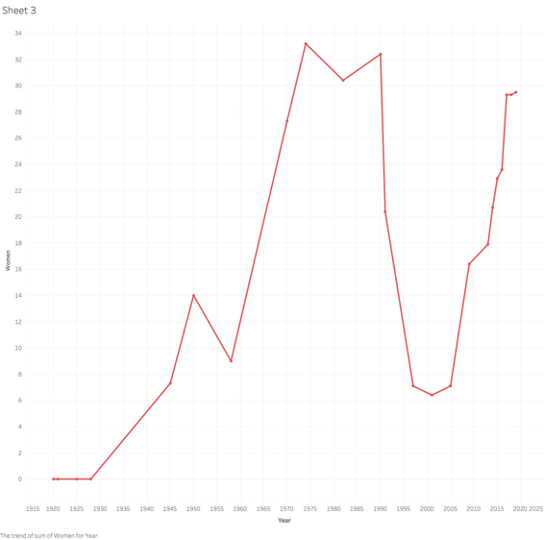Keeping with the theme from my first attempt from the mapping exercise, I decided to visualize the representation of women in the Albanian parliament for 1920-2019. This data was collected from the Albanian Institute of Statistics. I am familiar with some of these numbers because I have referenced in a paper a few years ago. I was looking forward to learning about later sessions of the government, and also to find out what the viz showed about women’s representation. The data is pretty straight forward, it looks at the number of women representatives in each Albanian legislature, and I was hoping the graph would mark a few points of extreme sudden highs and drops.
The first issue I had with the viz was that legislative districts have been redrawn many times over this period, and this visually seemed to exaggerate the gender disparity, thus rendering the path of women representation less obvious. I decided that instead of comparing male and female representatives, I would include the total number of the representatives and the total number of women for each administration. This made the numbers of women legislators a bit more clear. I decided to focus on this viz and also produce a simple graph of the percentage of women in parliament, to be able to look at the trajectory only. This trajectory is not the steady increase that one might expect; it marks extreme highs and lows in representation that bring up a few questions.



The first moment on the viz is the complete lack of women’s presentation from 1920 until after WWII. This time marks the rule of King Zog, and later Mussolini, followed by WWII, but this is not surprising or interesting for the purposes of this exercise. Another notable moment is the sharp increase of representation of women in the late 1970s. This was the peak of women’s emancipation movement by the Hoxha regime, but what is interesting is that in the middle of a huge campaign to include women in his government, that number begins to decrease in the 1980s and picks up again after his death and during the democratic movement in 1990. Albania was not a democracy at this time, and these representatives were hand-picked from the ranks of the communist party, which included as many women leader as men. Whey did Hoxha elect to decrease the number of women? What might perhaps be the most shocking part of the graph, is that women’s representation sharply decreases in the legislatures after the fall of communism. In 2001, there were only 9 women in a legislature body of 131. Women’s presence has steadily increased since 2005 and it is now at almost 30%. What caused this drop and what changed after 2005?




That drop in numbers with the fall of Communism is indeed very interesting. Do you know if there were any gender quotas in governing bodies in Communist Albania (or other political periods)? I think this was a practice in some other Communist governments in Eastern Europe (e.g., Yugoslavia). I wonder if that contributed to the fall in numbers (or perhaps the increase after 2005).
There were no official quota for gender representation in the communist parliament. While the Party’s Bureau selected and approved all representation in the parliament, there was some freedom of ‘upward mobility’ within the ranks of the party. In the early 1970s there was a backlash against the emancipation movement, and the Party itself rolled back many initiatives. The graph hints at this moment. My capstone project will deal with the cultural event in 1972 that inspired this backlash (think something like Eurovision), and how the latter influenced the immediate post-communist era.
The gender quota only came in 2008, when the Gender Equality Act was passed in Albania, requiring at least 30% of candidates (and at least one of the party’s 3 top candidates) to be women.
Oh, color me intrigued about your capstone project!